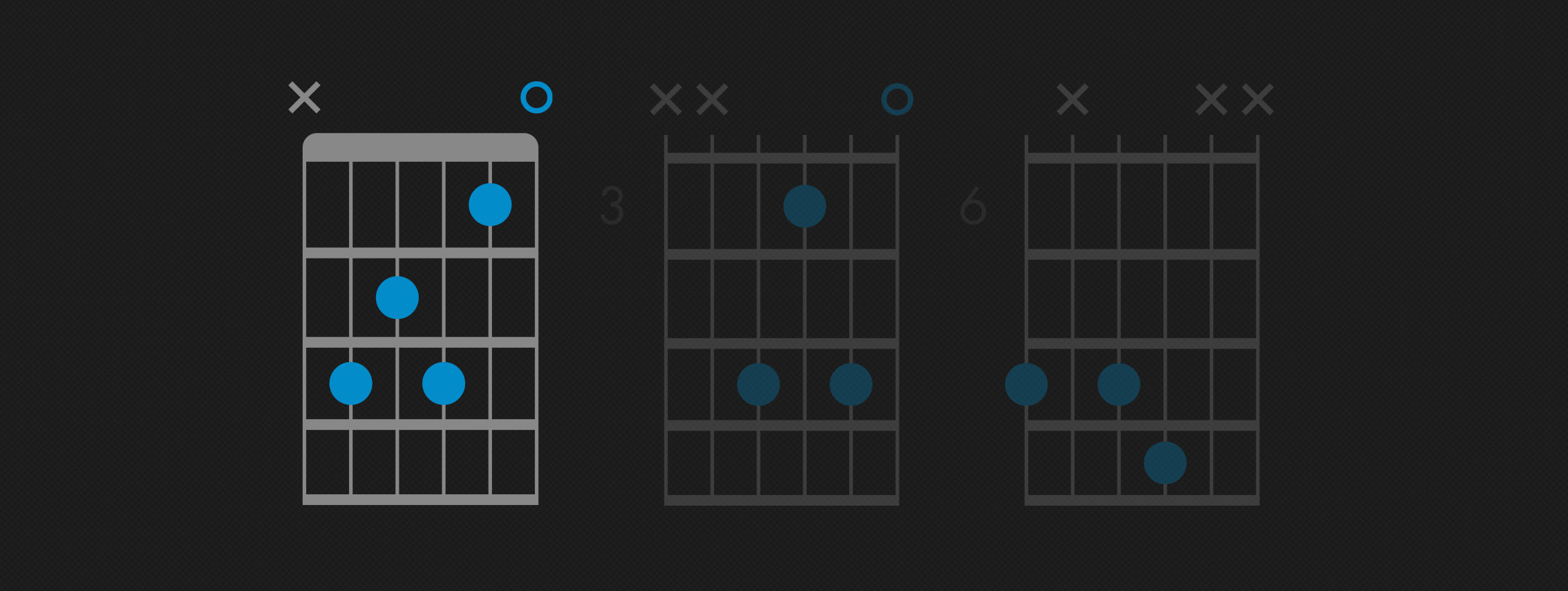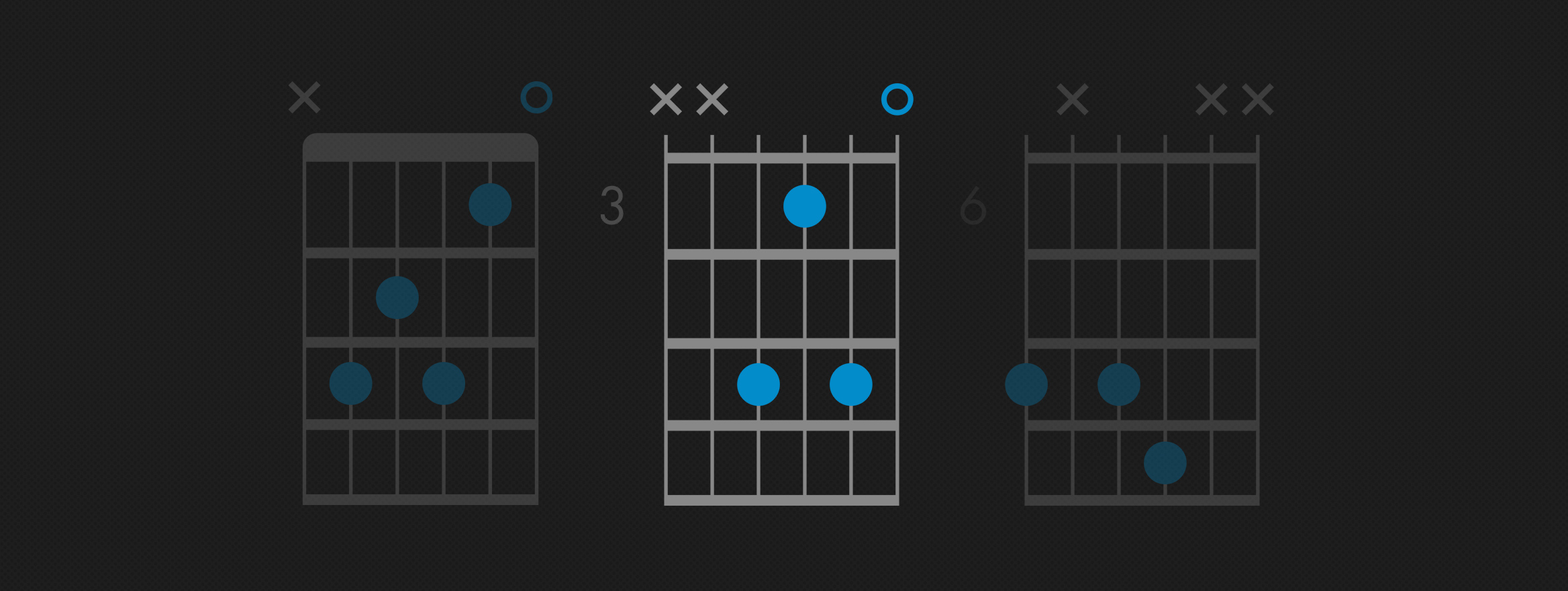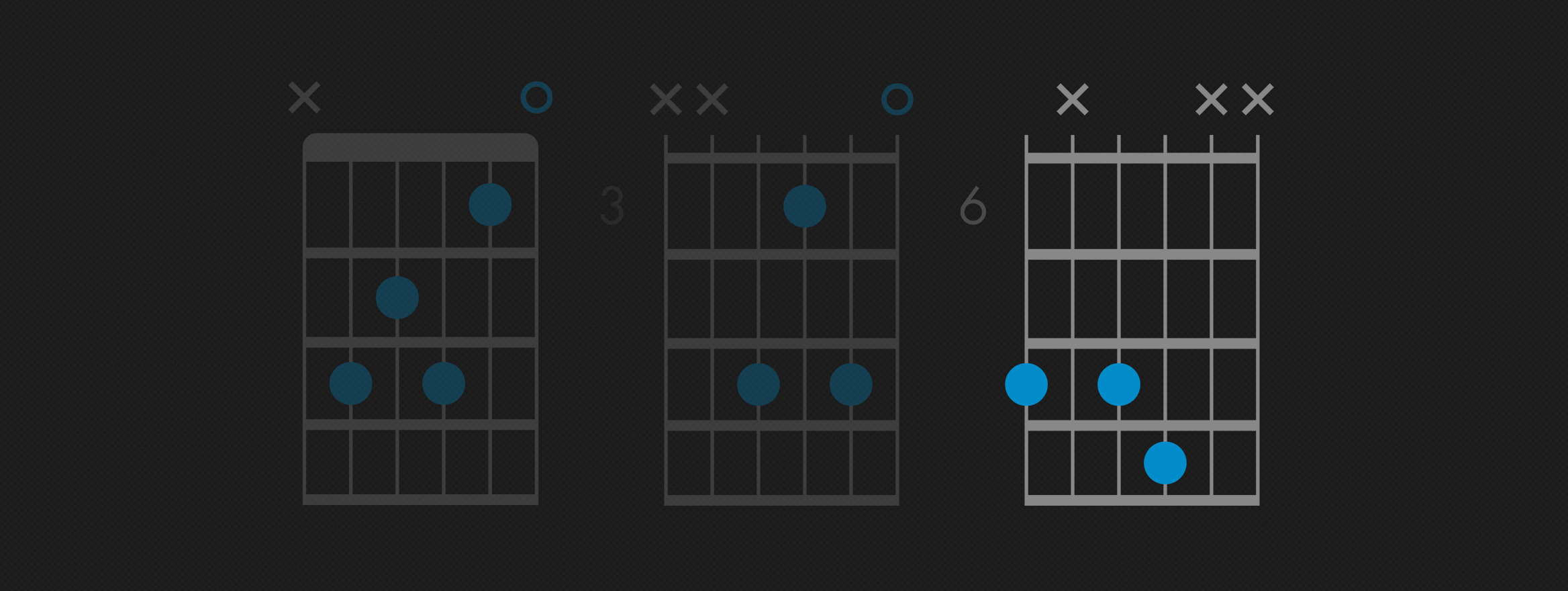
Sections
The C7 - or C dominant seventh chord -- has a quavery brightness to its tone. It can create a hesitant, tentative mood in a song, or can play with other chords in a song’s structure to produce a hopeful note (or string of notes blended together).
Ready to learn more about the C7 chord? Let’s dive in!
C7 Guitar Chord Finger Position: Three Ways to Play
The C7 chord is a variation on the standard C chord with one small addition - the seventh note, Bb. The addition of that one little flat note makes a big difference.
Seventh chords can be swapped into a song when its root note chord doesn’t sound quite right, or you want to add an extra twist to the song. Substituting a C7 for a C chord won’t always work, but half the fun is in experimenting with different chords to develop a sound and style you love.
One of the easiest ways to play the C7 chord is in the open position. This version only uses five of the six strings, but produces a strong, vibrant tone.
To play it, place your index finger on the first fret of the second (B) string. Drop your middle finger onto the second fret of the fourth (D) string. Finally, place your ring finger on the third fret of the fifth (A) string and your ring finger on the third fret of the third (G) string. Omit the low E string and strum starting with the A chord.
C7 Open Position
Middle finger: 2nd fret of the D (4th) string
Ring finger: 3rd fret of the A (5th) string
Pinky finger: 3rd fret of the G (3rd) string

Strum 5 strings down from the A (5th) string
While the open C7 produces the heartiest sound of the various versions of the chord, there are several other versions of the chord that take your playing to a “higher” level and tone.
The third position variation of the C7 chord has a higher pitch, starting on the (you guessed it) third fret of the guitar neck. This version only uses four of the six strings, making it sound higher and thinner than the open version.
To play it, start by placing your index finger on the third fret of the third (G) string. Stretch your ring finger down to the fifth fret of the fourth (D) string. Lastly, add your pinky finger to the fifth fret of the second (B) string. Strum from the D string downward.
C7 3rd Position
Index finger: 3rd fret of the G (3rd) string
Ring finger: 5th fret of the D (4th) string
Pinky finger: 5th fret of the B (2nd) string

Strum 3 strings down from the D(4th) string
One more version of the C7 chord takes it even further up the fretboard, beginning all the way down the neck on the 8th fret. This more advanced version requires you to mute the A string.
Start by placing your index finger on the 8th fret of the low E string. Use that index finger to slightly butt up against the A string to mute it. Then, place your middle finger on the 8th fret of the D string. Finally, drop your middle finger down onto the 9th fret of the G string. Strum four strings down from the low E string, omitting the B and high E strings. When strumming, be sure to mute the A string, otherwise, you won’t get the true sound of a C7.
C7 8th Position
Index finger: 8th fret of the low E (6th) string
Middle finger: 8th fret of the D (4th) string
Ring finger: 9th fret of the G (3rd) string

Strum four strings down from the low E string while muting the A string.
What Notes Make Up the C7 Chord?
As mentioned before, the C7 chord is almost the same as the C chord, with one small difference: the addition of a Bb.
The C7 chord is comprised of C, E, G and Bb notes. That seventh, flat note takes the C chord from its bright, airy sound to the slightly more wavering, tentative tone you hear when strumming a C7.
Don’t miss out!
Be the first to know about new products, featured content, exclusive offers and giveaways.
Songs that Use the C7 Chord
The C7 chord crops up in a variety of songs spanning a wide swath of genres. Here are just a few songs where you can hear - and play - the C7.
Rock Songs
The Beatles wove a sprightly C7 chord into one of their earliest hit songs, “From Me to You.” This chipper, harmony-laden song sees guitarist George Harrison playing a jaunty and jangly C7. It wouldn’t be the last time he’d incorporate the seventh chord into one of his arrangements. You can also listen for it on “Taxman,” “If You Believe” and “Something.”
Pop Songs
The pins-and-needles nature of the C7 chord makes an appearance on two pop classics: “Baby Love” by The Supremes and Eric Carmen’s “All By Myself.” On “Baby Love,” the C7 chord provides that “question mark” to what feels like a one-sided relationship. The chord also resonates with lonely heart Eric Carmen in his plea for love.
But the C7 isn’t all hand-wringing and The C7 chord’s bouncy flipside can be heard on “Bare Necessities,” the Disney classic from The Jungle Book with “Baloo the Bear” on vocals. The song’s upbeat, sunny outlook on life is propelled forward by an array of dominant 7th chords, such as the G7, A7, E7, and D7 - with a few minor chords thrown in for good measure.
One of the most recognizable songs of all time, “When the Saints Go Marching In” straddles the lines between gospel, pop, and jazz. Instantly evoking the feel of New Orleans, you don’t need a full horn section to see how the C7 chord gives this classic its punch. Incorporating bass note strumming - along with the chords themselves - makes this song a little more challenging and even more fun to try to play.
Blues Songs
The tenuous nature of the C7 chord aligns perfectly with the blues. Rev. Gary Davis puts the C7 chord to work in his “Hesitation Blues,” while Buddy Guy (like Eric Carmen) also calls upon the chord to make a case for romance on “Let Me Love You Baby.” A statement and a classic, Buddy Guy’s legendary song has been covered by fellow guitar luminaries like Stevie Ray Vaughan and Jeff Beck.
Country Songs
The C7 chord’s versatility is on full display within country music, with some of the genre’s most beloved artists using it in recognizable classics.
Hank Williams - the original and founder of the Williams’ dynasty that’s been a staple of country from the 1950s to the present - includes the C7 on one of his biggest hits, “Hey Good Lookin’.” It stands alongside two other 7th chords (C7 and D7) as well as a C and F chord to create the definitive version of this classic that’s been covered by too many artists to count.
Moving a little further down in country chronology, Conway Twitty uses the C7 chord on his plaintive “Hello Darlin’” to create an air of uneasiness when reuniting with an old lover. A staple of his catalog, Twitty would open his concerts with this song, acknowledging its status as a fan favorite and one of his signature songs.
Ready to start making the C#7 a valued part of your guitar category? Ready to learn additional chords? Browse Fender Play's chord library, learn about chord types, and find tips on how to master them
If you're not a member yet, sign up for a free trial here.


